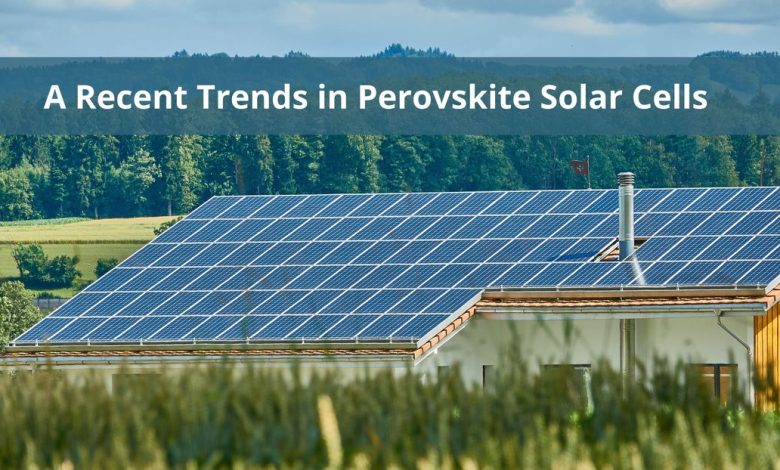A Recent Trends in Perovskite Solar Cells

An Overview of Perovskite Solar Cells –Thin-film PV technology is emerging, also known as 3rd generation PVs. It refers to PVs that rely on new materials or can overcome current efficiency and performance limits. DSSC, organic photovoltaics (OPV), quantum dots (QD), and perovskite PV form this new PV generation.
Perovskite: What is it?
The perovskites are a group of materials that share the same crystal structure as a mineral of the same name. Russian mineralogist Gustav Rose first discovered perovskites in the Ural Mountains in 1839. He named them after Lev Perovski (who founded the Russian Geographical Society). Perovskites are minerals found in Earth’s mantle.
There are many varieties of perovskites. The most important of these for the solar industry are crystals containing inorganic and organic molecules connected by tin atoms and lead. In addition, it has exciting properties such as superconductivity and magnetic resistance. Due to their easy synthesis and distinctive structure, these flexible materials are ideal for enabling low-cost, high-efficiency photovoltaics. In addition to electric vehicle batteries, sensors, and lasers, they play a crucial role in the next generation of devices.
Meaning of Perovskite Solar Cell
The term perovskite solar cell refers to any solar cell containing an active layer composed of an organic-inorganic lead/tin halide material mixed with a perovskite structure. It is relatively easy to manufacture methylammonium lead halides, one of the cheapest and easiest materials to produce. Perovskites are potential materials for solid-state solar cells. In addition, they possess intrinsic properties like broad absorption spectrum, fast charge separation, long electron and hole transport distances, long carrier separation lifetime, and more.
A perovskite solar cell is without a doubt the future of photovoltaics. Solar panels made of these materials are causing excitement in the solar industry. In addition, due to their ability to absorb radiation from almost all visible wavelengths, they have an exceptional conversion efficiency of more than 20% in the lab. Additionally, they are relatively easy to fabricate.
What is the process of making perovskite?
“Wet chemistry” is a method for creating perovskites. In addition, the materials like lead methylammonium iodide and lead methylammonium halide are mixed together in a solution. This mixed solution then deposits on a substrate like glass, flexible polymers, metal oxide, a silicon solar cell, or even transparent wood (wow).
In most cases, perovskite solutions are depositions via spin-coating. It is similar to the Spin-Art machine children use to draw splotchy pictures on thick paper. It drips or sprays the solution onto the substrate. As it spins, a thin layer of solution spreads across its surface. Solvents in the mixture evaporate, leaving perovskite films behind. Further, the thin layers of perovskite crystals are ready for wiring into solar cells.
Perovskites: Why they are important?
Perovskites are exciting for several reasons, but their photovoltaic effect is the most important.
These materials can produce solar cells similar to silicon, whose main component is tin. They are ideal for forming molecules with other atoms that are semiconductors, meaning light can excite electrons in these elements and direct them along a wire to generate electricity.
Perovskite crystals, on the other hand, are relatively easy to make under ordinary conditions. It is necessary to heat silicon to extremely high temperatures to get sufficient purity and crystal structure to make electricity. Perovskites are created by mixing chemicals in a solution and coating a surface with that solution. For the most part, perovskite solar cells will probably be significantly cheaper and easier to make than silicon solar cells in the future.
The ability of perovskites to produce electricity can also be controlled by controlling the types of molecules formed during manufacturing. Materials with the ideal bandgap can carry electrical charges across a circuit because of this tuning. The bandgap is the amount of energy necessary to push an electron to the next energy level.
Pros of Perovskite Solar Cells
- The process of making and depositing on a surface is relatively inexpensive and straightforward.
- It can produce high conversion efficiency.
- There is a tunable bandgap, making it almost ideal for capturing solar power
- It uses 20 times less material than silicon cells. In addition, it doesn’t require rare earth metals for production.
- It requires considerably less energy than traditional solar cells.
The Future Prospects of Perovskite Solar Cells
According to Astute Analytica’s report on the global perovskite solar cells market is forecast to grow at a compound annual growth rate (CAGR) of 28.7% during the forecast period from 2021-2030. The rising demand for solar cells is due to their flexibility and lightweight. In addition, the increasing number of applications in various industries. Additionally, with the advent of alternative energy sources, environmental concerns regarding carbon dioxide reduction have increased. These are some of the factors expected to boost market growth. Further, the increase in R&D efforts, and technical developments, could lead to the expansion of the market during the forecast period.
Recent Trends in Perovskite Solar Cell
A unique ETL technology enables highly efficient flexible perovskite solar cells.
A team of scientists led by Prof. Yiqiang Zhan from Fudan University reported annealing a SnO2 ETL in a rough vacuum at a low temperature (100 °C), resulting in high-efficiency flexible perovskite solar cells (f-PSCs).
These layers of SnO2 have demonstrated higher robustness and hydrophobicity than samples produced in an air atmosphere at 100 degrees Celsius. It also improves the ETL/perovskite interface connection while reducing defects in the SnO2/perovskite interface. The presence of oxygen vacancies on the surface during this treatment may result in higher conductivity. In addition, it is beneficial to charge transfer.
ETL-free and HTL-free inverted perovskite solar cells
A team led by Professor Lioz Etgar at The Hebrew University of Jerusalem recently studied how electron transport layers (ETLs) and hole transport layers (ETLs) affect the performance of inverted perovskite-based SC structures.
Specifically, they focused on inverted architecture. It eliminates the ETL and HTL from the solar cell structure. The study examined three architectures: an inverted structure, an ETL-free structure, and an HTL-free structure.
A carbon-based perovskite solar module with improved performance due to light
A team of scientists from Kishu Giken Kogyo and the University of Hyogo in Japan, Solaronix in Switzerland, and Fraunhofer ISE in Germany. The researchers examined the long-term stability of perovskite solar cells using mesoporous carbon layers.
There was a light-soaking effect in this work. It also enabled scientists to fabricate cells that retained 92% of their original performance after 3,000 hours in damp heat conditions. The researchers say that this is equivalent to 20 years of work in the field.
The NanoQI project develops multimodal real-time methods.
NanoQI is a project funded by the European Union under Horizon 2020. The project aims to develop a real-time, in-line, industry-ready method for characterizing and imaging the nano dimensions of (thin film) nanomaterials. In addition, the critical range of 1 to 300 nm applies to large samples of more than 500 × 500 mm2. As of March 1, 2020, eight companies and organizations from five countries were involved in the project.
Read about The Smart Management of Batteries





